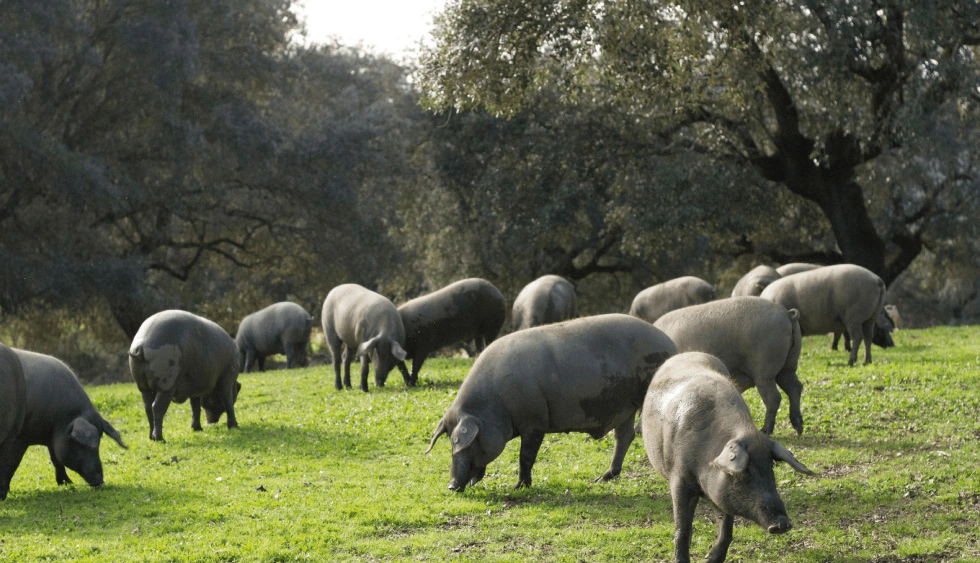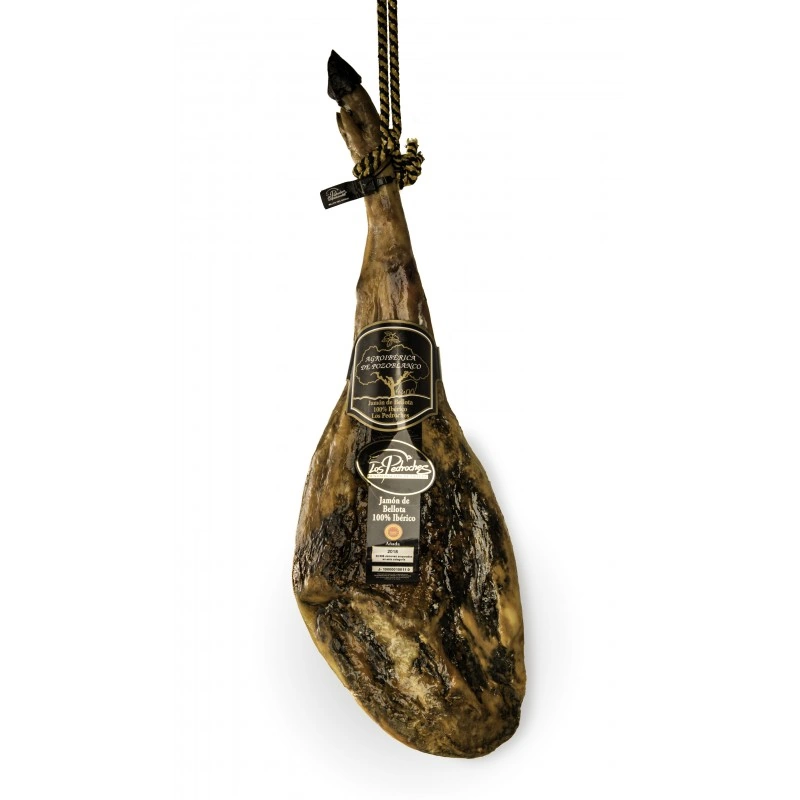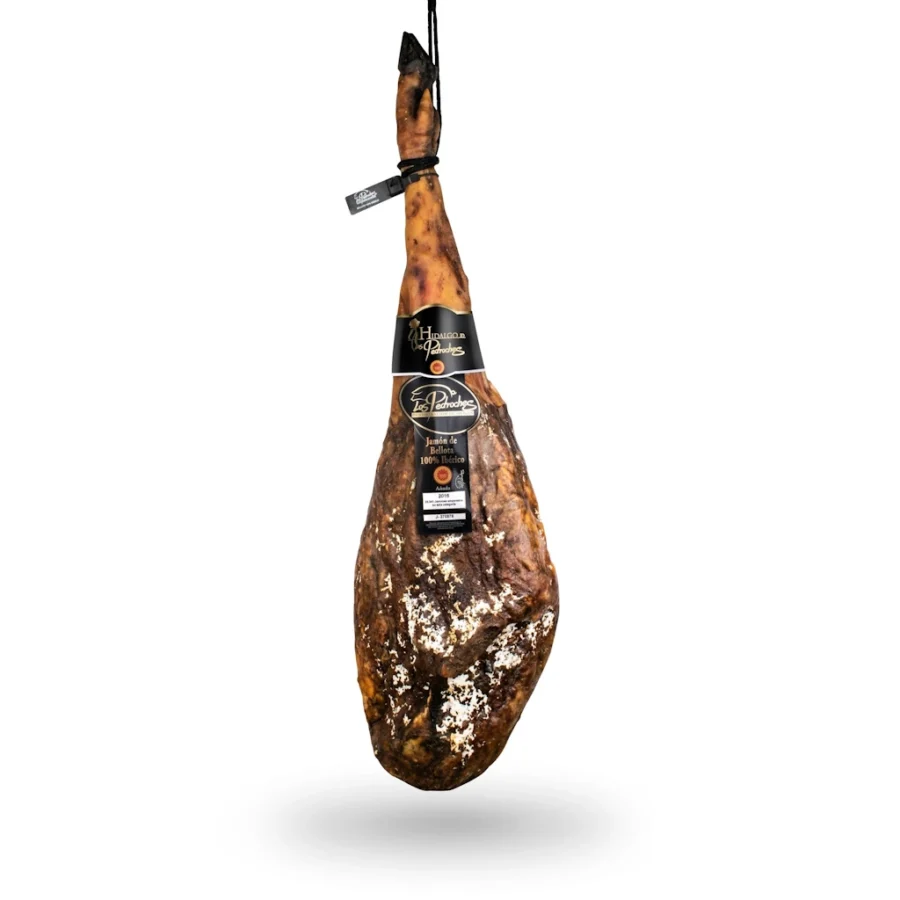The Iberian Pig: A Treasure of the Dehesa
Indice

What makes the Iberian pig and its products so special?
When we talk about gastronomic delicacies, the name “Iberian pig” resonates strongly, evoking images of intense flavor and delicate textures. The Iberian pig is not just any pig. It is a native breed of the Iberian Peninsula, with unique genetic characteristics that distinguish it from other pig breeds. Its main distinguishing feature is its ability to infiltrate fat into the muscle, which gives its meat that characteristic marbled appearance and a juicy and unparalleled flavor.
The Dehesa: Its Natural Kingdom
The natural habitat of the Iberian pig is the dehesa, a unique ecosystem shared between Spain and Portugal. Imagine vast expanses of land dotted with holm oaks, cork oaks, and grasslands. This environment not only provides food for the Iberian pig, but also directly influences the quality of its meat.
During the montanera (mountain season), the period from approximately October to March, Iberian pigs roam freely in the pastureland, feeding primarily on acorns, the fruit of holm oaks and cork oaks. This diet rich in oleic acid is essential for the development of infiltrated fat and for the characteristic flavor of their products. It’s as if nature itself imbues the meat with a unique aroma and taste.
Types of Iberian Pigs
Not all Iberian pigs are the same. To understand the differences, we must look at two key aspects: their diet and their percentage of Iberian breed purity. According to their diet, we can find:
- Iberian Acorn-Fed Pig: This is the king of its category. These pigs are raised free-range in the pasture and feed mainly on acorns during the montanera period. Their meat is the most valued for its flavor, aroma, and texture.
- Iberian Cebo de Campo Pig: These pigs are also raised free-range or on free-range diets and feed on natural pastures and complementary feed. Their quality is excellent, although slightly inferior to that of acorn-fed pigs.
- Iberian Cebo Pig: These pigs are raised on farms and feed mainly on feed. Their quality is good, but not as excellent as the previous pigs. Regarding the purity of the breed, it is classified according to the percentage of Iberian blood it contains. A 100% Iberian pig comes from 100% Iberian parents, while crosses with other breeds, such as the Duroc, produce Iberian pigs with 50% or 75% purity. This purity influences the characteristics of the meat and its price.
Iberian Ham: The Jewel in the Crown
When we talk about Iberian pork, it’s inevitable to mention its star product: Iberian ham. This delicacy is obtained from the hind legs of the Iberian pig and is cured slowly, a process that can take between 24 and 48 months, or even longer.
Patience and care during curing are essential for Iberian ham to develop all its nuances of flavor, its intense aroma, and its creamy texture. Each slice is an explosion of flavor in the mouth, with notes reminiscent of acorns, the herbs of the pasture, and the curing process itself.
As with pork, Iberian ham is classified according to the animal’s diet and its breed purity. “Jamón Ibérico de Bellota 100% Ibérico” is the ultimate expression of quality and flavor.
Beyond Ham: Other Iberian Treasures
Although ham is the best-known product, the Iberian pig offers a wide variety of cuts and cured meats of exceptional quality. Iberian loin, Iberian chorizo, Iberian salchichón, and Iberian shoulder are just a few examples. Each has its own flavor and texture characteristics, but all share the quality and unmistakable flavor of the Iberian pig.
A Cultural and Economic Legacy
The Iberian pig is not just a gastronomic product; It is part of the culture and history of the Iberian Peninsula. The dehesa, its home, is a valuable ecosystem that has been sustained for centuries thanks to the breeding of this animal. Furthermore, the Iberian pig industry generates employment and wealth in many rural areas, contributing to sustainable economic development.
An Unmistakable Flavor
The Iberian pig is much more than a simple farm animal. It is the result of a unique breed, a privileged natural environment, and an ancient tradition. Its ability to infiltrate fat, its acorn-based diet, and the careful curing process of its products result in an unmistakable flavor that makes it a gastronomic treasure appreciated around the world.
The next time you tryA slice of Iberian ham reminds us of everything that lies behind it: the pasture, the holm oaks, the acorns, the patience of curing, and the legacy of a tradition. Understanding its origin and characteristics allows us to appreciate this unique delicacy even more. It’s a piece of the earth, a flavor that tells a story.
Nota importante: aceitedelcampo.com promueve el consumo del aceite de oliva virgen extra por sus cualidades culinarias y beneficios para la salud. No obstante, no debe sustituirse ningún medicamento o tratamiento actual sin la orientación de un profesional de la salud.



